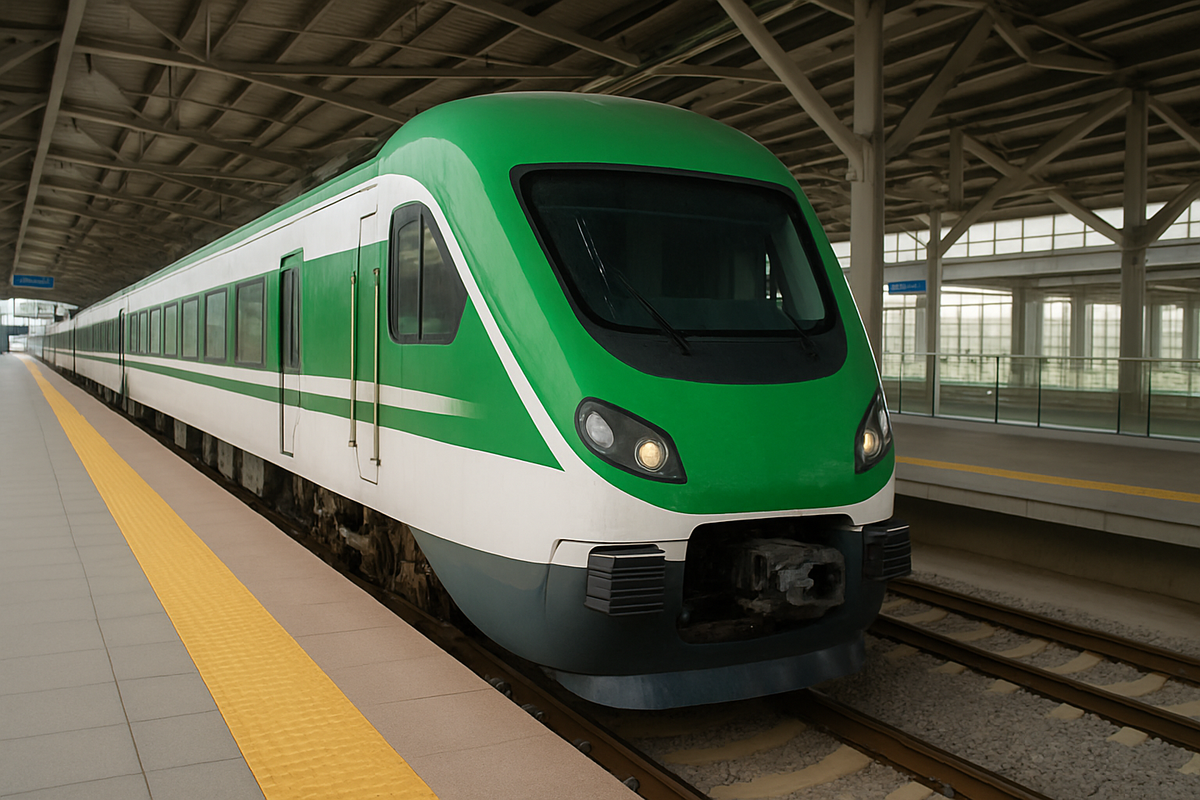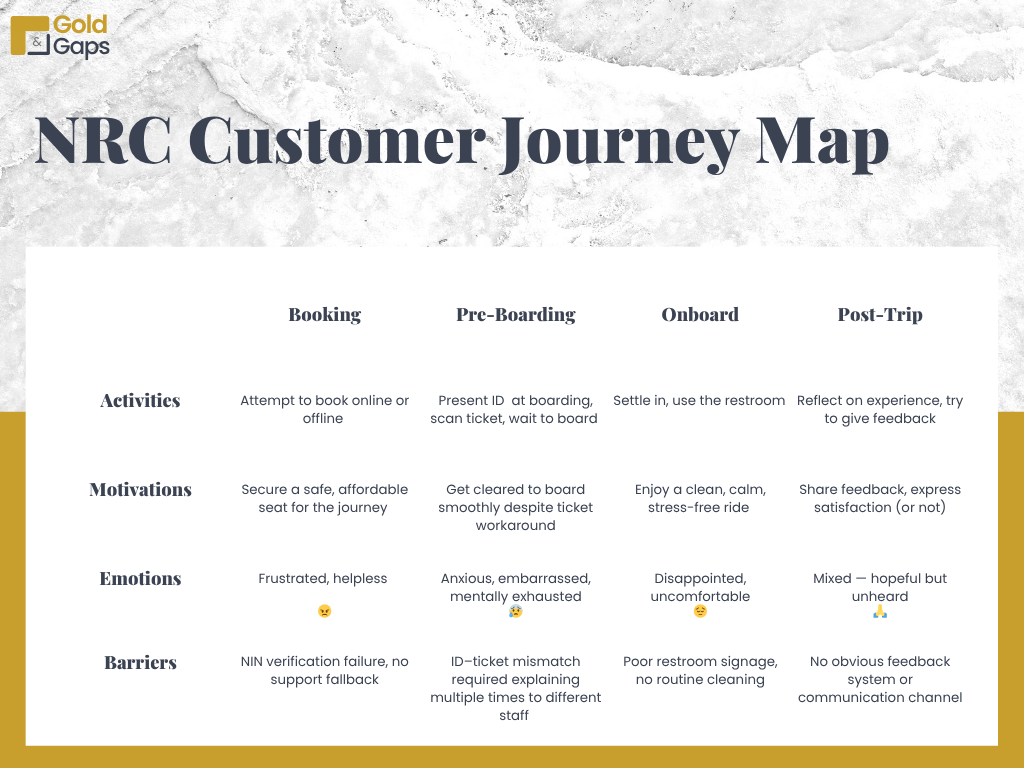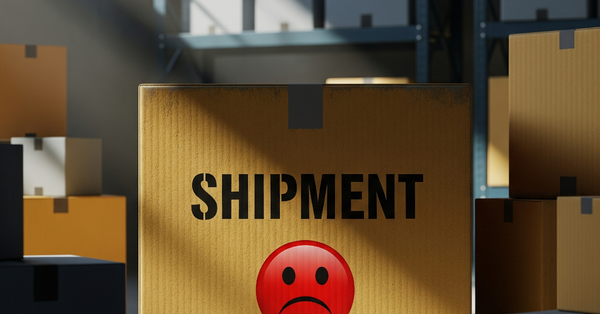My First Train Ride in Nigeria — Here's Why the NRC Must Rethink the Customer Journey

After waiting over two decades, I finally boarded a train in Nigeria on April 29, 2025. I’d heard glowing accounts about the revived Nigerian Railway Corporation (NRC): affordable fares, efficient timing, serene cabins. When the opportunity came to travel from Lagos to Ibadan, I was genuinely excited. This would be the calm, modern alternative to chaotic road travel.
And to be fair, it was mostly calm.
The Lagos station was impressively orderly. The waiting area was clean, spacious, and secure. No crowd pushing. No unnecessary noise. Pre-boarding was swift. The train departed on time. Business class offered wide seats, working air conditioning, and consistent onboard announcements. First class? Even better, reclinable seats that one could turn around – serenity achieved.
But beneath the surface of that calm ride, I encountered enough digital friction and service inconsistencies to frustrate even the most patient traveller. This activated my Customer Experience (CX) instincts.
Booking a Ticket or Attempting One
I tried to book my ticket online.
The NRC booking portal required National Identification Number (NIN) verification, a reasonable security feature in theory. But in practice, it failed multiple times without explanation. No helpful error messages. No retry guidance. No human fallback.

Eventually, a friend I travelled with helped me complete the booking. Not because they knew something I didn’t, but because we kept trying different workarounds until something finally worked. Did I mention that the ticket wasn’t booked in my name? You’d agree that this defeats the entire purpose of a NIN verification.
I assumed it was a one-off glitch. It wasn’t.
At the Chief Obafemi Awolowo Train Station at Moniya, Ibadan, we attempted to buy a return ticket in person, expecting the analogue process to be smoother. There was no queue. And yet, we spent over 50 minutes with the staff due to the same NIN verification issue. Some staff were polite but lacked the knowledge to resolve the issue. No one could confidently explain what was wrong, and no one had a solution, except ‘let's try another NIN’.
Worse still, there was no customer service desk, helpline, or QR code to scan for help. I lost count of how many times I said, ‘This is not a good user experience’, and began to wonder: How does a public transport corporation with N900 million invested in digital transformation not have a working support system?
Onboard: Clean Ride, Dirty Experience
Back on the train, the ambience delivered: wide seats, smooth ride, cold air, maybe a little too cold…until nature called.
The restroom had been used but not flushed. I sighed and cleaned it myself with the sanitiser spray I had. When I wanted to flush, I scanned every surface for a button, but nothing obvious was found. Eventually, I found it after I almost peed my pants.
Why was there no simple sign? Despite onboard announcements reminding passengers to keep restrooms clean, there were no adequate visual cues. A bold sticker labelled ‘FLUSH’ would’ve made all the difference.
From Customer to CX Practitioner
To be honest, I’ve been the average Nigerian for most of my life – ranting about almost everything, and it’s exhausting. So I decided that I would no longer complain about inconsistencies in experiences – that would just make me look like a bitter aunty. I’d rather channel my energy into making things better, in my little way, regardless of my societal standing.
That’s why after my trip, I did what I do best to ensure my experience wasn’t just anecdotal: wearing my CX hat, I researched the NRC experience, especially the digital touchpoints, mapped the customer journey, benchmarked it with the best globally, and uncovered the gaps.
But First, Data
I wanted to know what people were saying, so I went through online articles and videos, and found out that the digital ticket booking service was not only available on the website but also on mobile applications – Breeze-NRC for Android OS and NRC LITS ticket Booking App for iOS. Of course, I was excited to get some insights, so I checked the App Store for ratings and reviews.
User reviews for the NRC LITS Ticket Booking App on iOS revealed an alarming average rating of 1.7 out of 5 stars, from 40 ratings at the time of writing. The extreme dissatisfaction is encapsulated by one user's comment labelling the iOS app as ‘An App that belongs in the trash’.

I then checked the Google Play Store to see if this sentiment would be mirrored; there were over 12,000 reviews, so I scraped 500 reviews as my sample data – 200 Most Relevant, with no date filters, and 300 Newest; the oldest review in this category was from 17th February 2024. Combining the newest reviews with the most relevant, the total period covered was January 2021 to May 2025.
I conducted a sentiment analysis on the reviews by performing a keyword-based tagging using a custom REGEX formula, validated it manually to correct false positives/negatives and missed tags, and here’s what I found:
- The rating was better on the Google Play Store (4 out of 5); however, the sentiments were 57.3% negative, 24.3% positive, and 18.4% neutral.
- Key pain points include ticket booking challenges, NIN verification, and app functionality/crashes.
- Multiple users were debited without receiving tickets.
- Many believe the online platform is intentionally faulty, forcing travellers to buy tickets at inflated counter prices, where racketeering is suspected.
- The N900 million e-ticketing platform has become synonymous with distrust, friction, and corruption.

The Train Ride Was Smooth. The Customer Journey? Not So Much.
To get a clearer picture of the full experience, I mapped it using a simple Customer Journey Map (CJM) — a tool we use in CX to visualise how people move through a service, where they struggle, and what they feel emotionally or experientially at each stage, because it’s never just about the ride itself, but every interaction before, during, and after.

In NRC’s case, the journey started long before I boarded the train, and it didn’t end when I got off. In CX, great design isn’t about flashy tech; it’s about how well systems anticipate needs, solve problems fast, and make people feel cared for at every step.
The Stakes of Experience
While my experience with NRC provided unique insights, the challenges I encountered are not isolated. Globally, customer experience has become the primary battleground for businesses, and its impact on an organisation's bottom line is undeniable.
- According to Forrester’s 2024 US Customer Experience Index Rankings Report, Companies that prioritise CX see 41% faster revenue growth, 49% faster profit growth, and 51% better retention.
- Customers are 2.4 times more likely to stick with a brand when their problems are solved quickly. (Forrester Analytics, 2020)
- Bad customer experiences put trillions of dollars at risk in global sales annually, as over half of consumers will cut spending after just one poor interaction. (Qualtrics, 2024)
- Ultimately, organisations that truly deliver on customer expectations see higher customer lifetime value, reduced churn, and stronger brand reputation.
For the NRC, and indeed for any service provider in Nigeria, understanding and intentionally designing for the customer journey isn't just about good service; it's about building trust, ensuring long-term sustainability, and capturing the immense value that satisfied, loyal customers bring.
Benchmarking: Learning from the Best
So, what does great CX look like? I examined several globally respected metro systems, including Tokyo, Hong Kong, London, Singapore, and Taipei.
But the one that stood out wasn’t the biggest or the flashiest – it was Singapore’s MRT (Mass Rapid Transit). Why? Because it’s not just operationally efficient, it’s intentionally designed for the customer – from seamless mobile booking to real-time support and feedback loops that actually work, Singapore’s MRT shows what happens when infrastructure and experience grow together.

NRC doesn’t need to replicate Singapore’s MRT overnight. But it can start by asking the same question Singapore did: ‘How do we make every step of the journey feel like it matters?’
Final Thoughts: NRC Has the Tracks, Now It Needs the Touch
There’s a lot to applaud. NRC’s infrastructure is a great start. The trains are modern. The stations are improving. The promise of rail travel in Nigeria is real.
But a good ride isn’t enough. Not anymore.
Today’s passengers expect a good journey, from start to finish. Booking should be seamless. Support should be accessible. Issues should be solved fast. Feedback should be heard. Friction points should be designed out, not worked around.
Based on my experience, research, and mapping, here are a few practical CX fixes that could be implemented with minimal disruption but significant impact.

Improving customer experience doesn’t always require massive new investments. Sometimes, it’s about removing friction, adding clarity, and listening a little better. A good journey is never just about the train – it’s about how the experience makes you feel, from beginning to end.
- Share this story with your network
- Post the link on your socials and tag @info_NRC (Instagram & X)
- Email a decision-maker if you know one
Let's amplify this, not to shame, but to shape a better rail experience for all.



